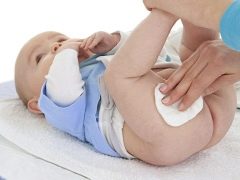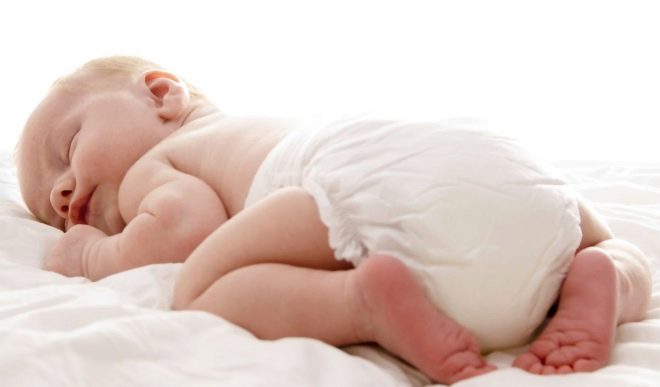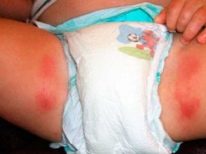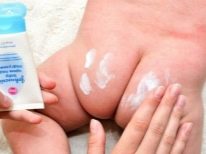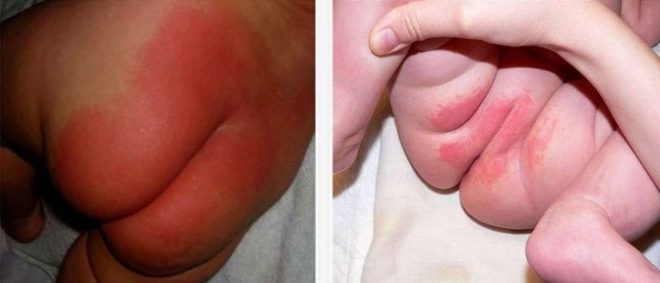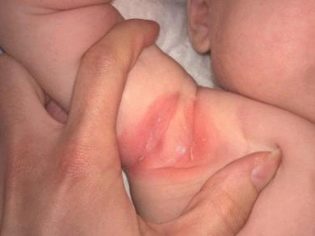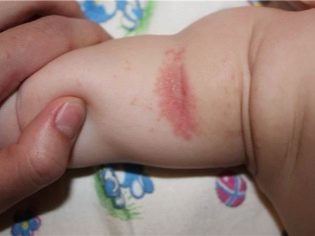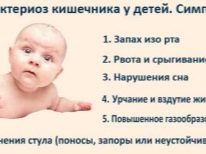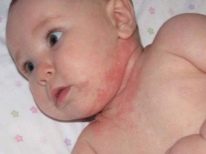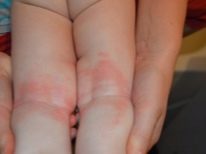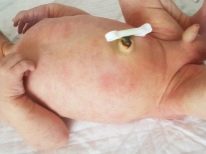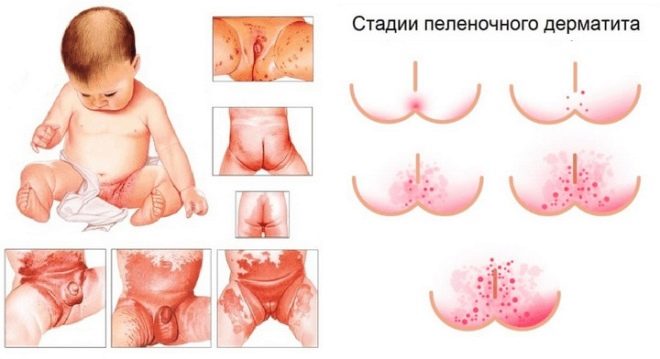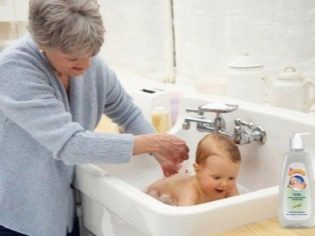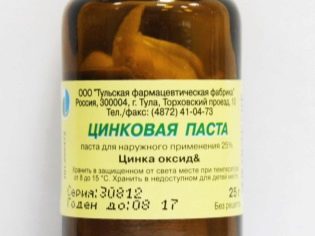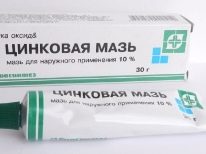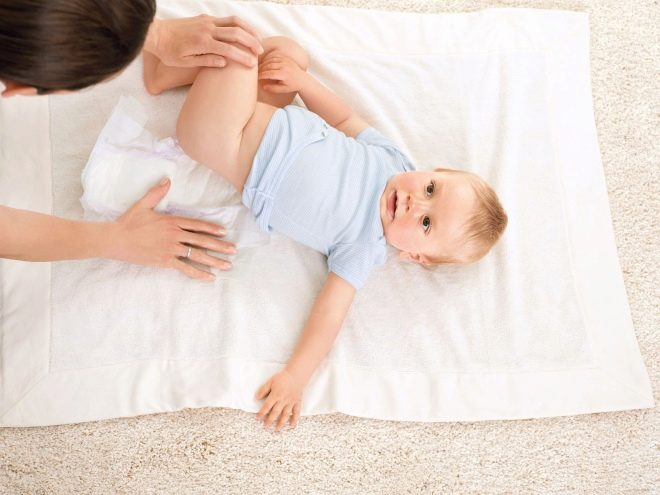Diaper rash in newborns: from appearance to treatment
Diaper rash in newborns and infants is a very widespread problem, and it is not only a matter of hygiene. With all the variety of cosmetic products for the care of children's skin, with all the efforts of parents to maintain dry and clean diaper rash. It is important to know how to distinguish them from dermatological diseases and what to do if your baby suddenly has diaper rash.
What it is?
Diaper rash is called localized localized inflammation of the skin on the background of long skin contact with urine, feces, sweat, skin fat, and also on the background of irritation from contact with wet surfaces.
The skin forms in utero, and only in the second half of pregnancy, the skin in children becomes four-layer, so it is considered one of the weakest and most vulnerable places in boys and girls in the first year of their life. The outer layer of the skin (the epidermis) in children is much thinner than in adults, it is quite loose, and therefore any infection can penetrate into the deeper layers of the skin. Full protection of the epidermis of newborns and infants can not be considered.
The skin of a newborn is very easy to damage, injure, and mechanically destroy its integrity, even during normal infant procedures such as swaddling or massage. And statements by manufacturers of children's cosmetics that “The baby’s skin needs special care” - not a publicity stunt, but the truth. The slightest adverse effect can lead to the formation of strong diaper rash.
Weeping deep diaper rash, severe prickly heat, often lead first to pyoderma - bacterial inflammation of the skin. The impaired integrity of the skin is an excellent prerequisite for the attachment of bacterial microflora. In the most severe variant, the bacterial infection becomes generalized, sepsis develops.
Why and how does it develop?
The water-lipid balance of the skin of children of the first year of life is imperfect, and therefore it can be disturbed at any time. It is an excess of moisture on the skin and is considered the main cause of diaper rash. Long contact of the skin of the infant with urine and feces is the most common prerequisite for the inflammatory process. The inflammation itself occurs in this case due to the effect on the epidermis of urea, ammonia and salts contained in the urine. In fecal masses, the main danger is represented by two enzymes - lipase and protease.
If for infants, for some reason, loose stools, diarrhea, everything becomes worse - such fecal matter is dangerous for the skin. not only its enzymatic component, but also the presence of an acidic environment. In diarrhea, even short contact of the skin with feces causes severe irritation in newborns and infants.
Most often, diaper rash develops from overflowing diapers if parents rarely change this infant's hygiene item. The skin of children easily absorbs moisture and is saturated with it, and therefore, insufficient drying of the skin after bathing can also cause diaper rash.
Salts dangerous for skin are also contained in sweat.. Sweat glands in children work very actively, this is a feature of the first year of life.If parents are unfamiliar with her, they may mistakenly try by all means to heat the nursery, put a couple of heaters on, warm the child. The work of the sweat glands becomes redundant, since the body of the child is trying to get rid of excess heat, to give it away. The salt environment of sweat affects the skin almost as much as urine.
A real revelation for parents is a situation where the temperature of the air in the room is normal, and the child does not bundle up, and diapers often change, and diaper rash all the same appear. In this case, the case is most likely in mechanical friction - can rub the diaper in the groin area, a vest under the arms, a diaper around the neck of infantsbut. Deep skin folds can also rub against each other - this is how local localized inflammation occurs in the groin, under the knees, under the arms, between the legs and even between the fingers.
The development of diaper rash can be promoted by a new supplement that has just been introduced into the baby’s menu, in which case the prerequisites will be allergic. A favorable background for the development of diaper rash is a period of illness - high fever increases sweating, as well as periods of treatment, in particular, antibacterial drugs.
Even if the antibiotics are not taken by the child, but by the breastfeeding mother, the child is more likely to have skin problems, since the antibacterial agents easily penetrate the breast milk.
Doctors have long noticed that children with genetically fair skin and fair hair are most often affected by diaper rash. Dark-skinned babies are less likely to suffer from hemorrhage, dermatological forms of allergies and diaper rash.
Particular attention to the prevention of diaper rash should be paid to parents of babies who are at risk for such pathology. To her pediatricians include:
overweight or obese babies;
children with allergies, especially those with hereditary forms of allergies;
babies diagnosed with intestinal dysbacteriosis;
children currently suffering from gastroenteritis or intestinal infection;
babies with pathologies of the kidneys and urinary system;
premature babies;
babies who are not on breast, and on artificial feeding.
Kinds
Only at first glance all the intertrigo is the same. In fact, in order to quickly cure them, you need to clearly understand what kind of skin inflammation belongs to.
The classification of diaper rash involves the allocation of them into separate groups for the root cause.
Diaper (diaper dermatitis) - manifested by inflammation and rash of varying intensity in the diaper area, where there is contact with urine, feces. Most often manifested in the priest, between the buttocks, in the groin, on the scrotum in boys and labia in girls, around the anus, in the lower abdomen. There are no rashes on the arms, legs, neck or back of the head.
Allergic (the so-called "allergic ring") - manifest the formation of a zone of inflammation in the area of the buttocks and anus. Rashes have a bright red color, they are small. They usually develop after changes in the diet, if an allergen has got into the baby’s food.
Foldable (Intertrigo) - affects only the skin folds in the groin, on the thighs, between the buttocks, under the knees, in the armpits, in the neck, on the handles in the elbows. Harmful factors - excessive moisture and mechanical rubbing inside the folds.
Seborrheic Eczema - a large red spot extending to the lower abdomen, groin, genitals. The spot has clear boundaries. The skin in the affected area becomes rough and oily, there is a slight swelling.
Fungal (candidiasis) - diaper rash can be based anywhere, but as such they become due to the addition of fungal organisms. The infection looks like a medium-sized reddish spots with a whitish tinge in the center, most often located in the groin and on the genitals.
Impetigo - diaper rash complicated by bacteria, most often streptococci or staphylococci. It looks like pustules, prone to merge with each other, they quickly burst and leave dry-looking crusts of golden, brownish color that look unpleasant. The most common place of dislocation - the buttocks.
Symptoms and signs, differential diagnosis
There are usually no particular difficulties in determining diaper rash among parents. It is enough to take off the child's clothes, diapers and a diaper, and the clinical picture is obvious. And here it is important to understand in time what you are dealing with - with impetigo or diaper dermatitis, with seborrheic eczema or an allergic ring.
First of all, the mother should assess the nature of the rash and compare them with infectious diseases. Infectious rash is almost always accompanied by high fever.. If the child is left without clothes for a couple of hours, the diaper rash will begin to decrease, fade, lighten, and the infection will continue to spread to other parts of the body. In the second case you need to call the doctor at home and determine what kind of infectious disease struck the baby and how to treat it.
The presence of pus and dry crusts always indicates the presence of a bacterial infection in the area of the inflammatory process. Whitish plaque - a sign of fungal infection.
In both cases, you need to consult a doctor and the appointment of specific treatment (antibiotics, aniline dyes for bacterial damage and antifungal drugs for mycosis). In other cases, the mother can handle herself.
Next, determine the degree of diaper rash. In modern pediatrics and dermatology, there are three degrees.
The first (it is easy). The skin is slightly inflamed, there are no weeping areas, visually on the skin there are no damages, cracks, wounds. The general condition of the child is not changed - appetite, sleep is normal.
Second (average). The inflamed areas have a bright red color, there are areas of erosion, the integrity of the epidermis is broken, there are small cracks, there may be small pustules. The child is restless.
Third (heavy). The area of the lesion is large, there is a swelling of the inflamed areas of the skin, cracks and detachment of epidermis fragments, ulcers, erosion. Signs of a bacterial or fungal infection may or may not be present. The probability of infection is very high. The child suffers from pain and burning, the sites of inflammation itch. The baby's state of health is disturbed, he cries, does not sleep well or does not sleep, refuses to eat. If the temperature rises - this is a sure sign of infection.
The first degree should not cause much concern. It is treated easily and quickly. When the second and third degree should show the child to the doctor.
Treatment
Treatment of diaper rash in newborns and infants should be after the type and extent of the disease has been accurately determined. Recommendations to show the child to the doctor with pronounced weeping diaper rash exist not in order to complicate the life of the mother and father, but in order for the treatment to be correct, precise.
Sometimes it is necessary to establish the type of bacteria or fungus to prescribe the most effective means.and in this case microscopic examination of the scraping from the epidermis on fungi, bacposa and other microflora is carried out. And in case of allergic diaper rash above the second degree, it is necessary to consult an allergist and a breastfeeding specialist if the child has not received complementary foods.
How to treat a precious child, depends on the degree of diaper rash it showed up.
First degree - easy
At the first degree, nothing special will be required from the mother. Quickly get rid of the trouble will help change the approach to hygiene and lifestyle of the baby. First of all, you need to check whether it is hot in the room. If the air temperature is above 21 degrees, you need to bring it to the values of 19-21 degrees of heat. Adults may not be comfortable enough such a temperature, but for the child it is ideal due to the peculiarities of thermoregulation.
The diapers need to be changed every 3-4 hours., that is, before each feeding, it is necessary to wash the child with warm water without soap, if there was no fact of defecation. After each bowel movement without delay, the diaper is changed out of schedule.
Baby needs air baths - stay without a diaper and diaper. Prickly heat and diaper rash do not like the flow of fresh air, and this should be actively used. For children's skin, when the inflammation disappears, especially in the interdigital area, you need to use a protective children's cream - it will help create a skin film that will repel excess moisture.
Pillsy and diaper rash cannot be cured with baby cream. It is always fat, it moisturizes, and does not dry, and therefore to fight with already existing diaper rash with its help is absolutely contraindicated.
Panthenol-based products - Panthenol, Dexpanthenol, Dexpan Plus, Bepanten, D-Panthenol, Panthenol-Spray, Heppiderm will help to remove the appearance of diaper rash on the skin. etc. You can use folk remedies for bathing and care, they will be discussed separately. Use of baby powder is acceptable.
Second degree - medium
When diaper rash second degree It is also important to bring the air temperature in accordance with the norms, not to muffle a child, to exclude all possible allergens, air baths and frequent diaper changes from its diet, which will also be an integral part of therapy..
In addition, parents should carry out treatment of the affected skin with special drying preparations based on zinc oxide. These include special “talkers”, which are prepared by a doctor’s prescription at any pharmacy with its own prescription department. Of the finished products should pay attention to the "Desitin", "Zinc Paste", "Tsindol." Treat sites of inflammation can be methyluracil and tannin ointments. Useful exposure to sunlight on the affected areas of the epidermis.
If small pustules are detected, the doctor usually prescribes anti-inflammatory and antimicrobial agents - Levomekol and Baneocin (powder and ointment) in combination with preparations of a drying action based on zinc oxide. After the foci of inflammation have passed, the prophylactic use of protective ointment or Purelan cream is recommended.
If diaper rash has developed on the background of food allergies, antihistamines are recommended at the age dose ("Loratadin", "Suprastin"), in severe cases - hydrocortisone-based ointment.
Third Degree (Severe)
The most difficult to treat at home is third-degree diaper rash. Such lesions require careful care and special medicines. Recommended therapeutic lotion with solutions of tannin, silver nitrate. This is necessary to ensure that eczema and ulcers cease to "soak." After this process is stopped, zinc paste is prescribed, antibiotic ointments.
At the same time, parents need to strictly follow the processing technique and sequence of actions:
the sore spot is treated with antiseptic ("Miramistin", "Chlorhexidine", hydrogen peroxide 3%);
after waiting a couple of minutes, they are treated with aniline dyes (“Fukortsin”, green paint, methylene blue);
after letting the surfaces dry, they apply an ointment recommended by a doctor with an antibiotic or zinc oxide (the best thing is to alternate: in one treatment use the drug with zinc, in the other - an antibacterial agent).
Treat skin should be at least 3 times a day. Additionally, you must comply with all the above requirements for hygiene, air temperature, air baths and so on.
When wounds on the skin, ulcers and eczema, do not use powder and baby cream.
Folk remedies
For the treatment of light diaper rash, as already mentioned, you can resort to folk remedies. They are approved by pediatricians.There is a lot of advice on how to get rid of diaper rash on the Internet quickly and easily at home, but not all of them are rational and rational, and some are dangerous for infants. Therefore, we divided them into permissible and unacceptable.
What can?
With any degree of pathology, parents can arrange for a baby bathing in a bath with the addition of oak bark decoction. A glass of oak bark brewed with two liters of boiling water, well insisted and then add the broth (after straining) in the water for bathing. Do not do such a healing bath daily practice. It will be quite enough to take it every 2-3 days..
With the same success, you can make baths with a string, pharmacy chamomile.
Wetting of diaper rash with a decoction of eucalyptus leaves is allowed. Two large spoons of vegetable raw materials brewed with boiling water in a volume of 200 ml. Ready warm broth (not hot!) With a cotton disc is carefully applied to the sites of inflammation and the skin folds are smeared with it.
Why not?
Some recommendations of folk healers can cause serious harm to a child. First of all, this should include tips to remove diaper rash with iodine solution. Attempts to treat the inflamed skin with iodine can cause burns and overdose of this remedy.because it can accumulate in the body. This is fraught with the most serious consequences.
Also Dangerous advice should be considered to lubricate the affected skin with honey. - It is the strongest allergen that can cause a child up to 3 years more harm than good.
It is impossible to lubricate in the skin folds, behind the ears and in the groin with vaseline and sunflower oilbecause it creates a durable waterproof film on the skin, making it difficult for the damaged epidermis to heal. Of the oils, sea buckthorn is acceptable, but only in milder forms of pathology.
It is forbidden to use starch and tooth powder instead of powder. It is strictly forbidden to use any recipes with alcohol tinctures.
Opinion of Dr. Komarovsky
Famous pediatrician and TV presenter Yevgeny Komarovsky claims that advertised skin care products are not required for a child with healthy skin, but if the skin is unhealthy, then you need a clear understanding:
in case of diaper rash, high humidity you need to dry (drying creams, powder);
for dry skin, peeling, cracks need to moisturize (baby cream, oil, etc.).
And in no case can these rules be violated. Prophylactic treatment of the skin, according to Komarovsky, makes sense only in those places where the contact of children's skin with urine and feces is implied.
Oddly enough, but parents can help with diaper rash prevention disposable diapers, if they are of high quality, having a layer that quickly turns the liquid into a gel. In this case, the skin suffers significantly less. It is clear that the diaper does not protect against feces, but Komarovsky considers the combination of feces and urine to be the most dangerous and traumatic for delicate children's skin.
Treatment of diaper rash, Dr. Komarovsky considers "work on the mistakes" - parents should try to make sure that the skin is good and comfortable, indoor humidity was at the level of 50-70%, and the air temperature did not exceed 21 degreesso that the child is dressed for the climate and weather and not sweat. If a walk in a thick and warm jumpsuit in the winter did lead to the child sweating up, it is important to immediately rinse the child with warm water without soap, change into dry clothes.
And, of course, all fabrics with which children's skin contacts should be natural, with a minimal amount of textile dye.
Reviews
According to reviews of moms, diaper rash is treated fairly quickly, but there are some cases where parents for a long time fail to defeat the rash on the skin. It is usually about inflammation in places that are technically difficult to “air out” - the anus, interfrog fold.
Experienced mothers warn young parents of a common mistake - the abandonment of the already familiar "diapers" in favor of gauze diapers.
This decision is made by many, and in vain - wet gauze only enhances the inflammatory process and causes a mechanical effect on the already diseased skin areas.
Even more, about the causes of baby diaper rash and how to deal with them, learn in the next video.
